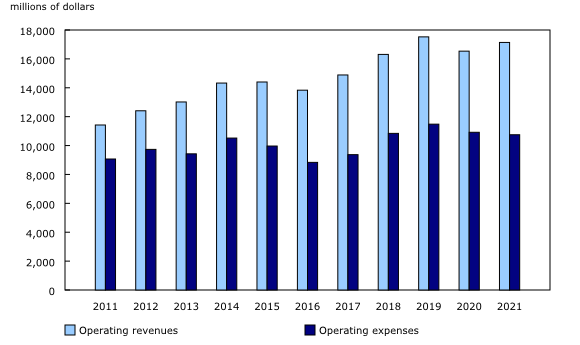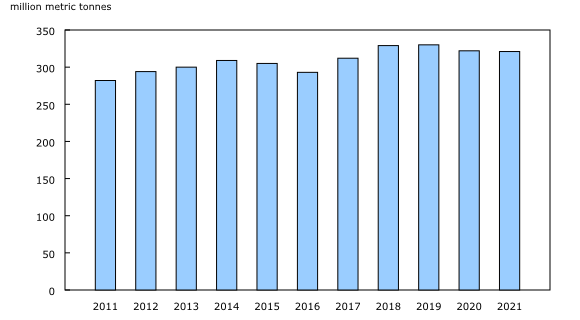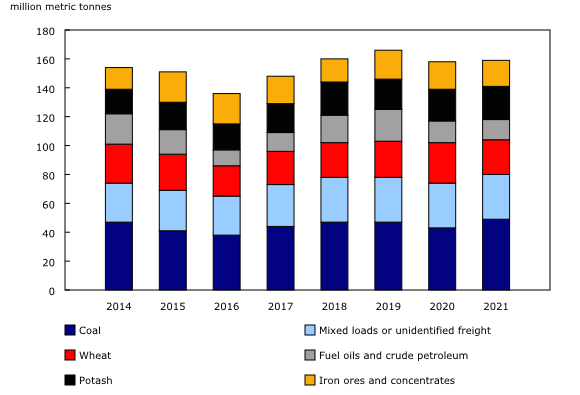Rail transportation, 2021
Released: 2023-04-05
Industry recovers from the pandemic
Rail industry revenues rose in 2021, as business activities resumed following the onset of the COVID-19 pandemic in 2020. Indeed, railways reported operating revenues of $17.1 billion, up 3.7% from 2020, but not quite reaching the record $17.5 billion posted in 2019.
The Canadian rail industry is comprised of two mainline freight carriers, several short line freight railways, along with passenger rail companies.
Freight revenues increase
Freight movements continued to dominate industry activity in 2021, accounting for 9 of every 10 dollars of operating revenues ($15.6 billion) and increasing 5.5% from 2020. Although the volume of cargo moved by rail remained flat in 2021, revenue tonne-kilometres edged up to 423.9 billion tonne-kilometres.
Passenger revenues slower to recover
Although passenger rail services remained affected by the impacts of the pandemic in 2021, passenger rail revenue rose to $132 million in 2021, an increase of 36.6% from 2020. At the same time, government contributions towards passenger rail services decreased by 11.3% to $424 million in 2021, as the impacts of the pandemic started to taper off.
Some expenses drop
In 2021, total operating expenses reported by railways declined 1.6% from 2020 to $10.7 billion. This decrease was led by general administration costs (-11.2% to $1.8 billion) and equipment costs (-7.1% to $2.0 billion), while costs of rail operations (-0.9% to $4.3 billion) remained relatively steady.
Conversely, maintenance of way expenditure rose by 11.2% to $2.6 billion in 2021. Fuel expenditures increased 5.5% from 2020 to $1.9 billion, due to the upward pressure put on oil prices by the reopening of national economies.
Bottom line, the industry's operating ratio (operating expenses as a proportion of operating revenue) decreased to 0.63 in 2021, down from 0.66 in 2020. In other words, for every $100 in revenue generated, railways incurred roughly $63 in expenses.
Operating performance
In 2021, the average number of employees reported by railways was 31,692, up slightly (+0.3%) from 2020. However, total annual wages and other benefits and emoluments in 2021 increased to $3.2 billion, up 5.6% from 2020.
In 2021, as economies reopened, railways earned more freight revenue compared with 2020. For instance, revenue tonne-kilometres (the movement of one tonne of revenue-generating freight over one kilometre of track) rose to 423.9 billion tonne-kilometres in 2021, up 0.9% compared with 2020. At the same time, labour productivity (revenue tonne-kilometres per railway employee) remained virtually unchanged (+0.6%) at 13.4 million.
Average revenue freight distance was up 2.9% from 2020 to 1,253 kilometres in 2021. Finally, average train speed continued to decline, slowing to 33 kilometres per hour in 2021, while the average number of cars per freight train edged up to 121 cars.
Overall freight volumes unchanged
While cargo movements by rail in the first half of 2021 were higher (+3.3%) compared with the same period in 2020, movements for the entire year decreased slightly by 0.2% to 321.1 million tonnes. Although shipment volumes rose for some commodities, some factors moderated these volumes, including supply chain disruptions andlower volumes of principal field crops, such as wheat, canola and barley.
Top commodities moved by rail remain steady
Agricultural and energy products remained key commodities for freight carriers in Canada. Of the top six commodities moved by rail in 2021, two had a year-over-year increase in tonnage: coal (+14.8% to 49.4 million tonnes) and potash (+2.8% to 23.1 million tonnes).
Conversely, wheat had the largest decline, down 17.1% (-4.8 million tonnes) to 23.5 million tonnes, while fuel oil and crude petroleum dropped 5.9% (-891 000 tonnes) to 14.3 million tonnes. Overall, the total volume of the top six commodities remained unchanged from 2020 and accounted for roughly half (49.6%) of the entire rail freight volume in 2021.
Note to readers
This release is based on two data sources, an annual survey and a commodity origin and destination statistics administrative file from Transport Canada. The former collects financial as well as operating and employment data from a census of Canadian railways that provide for-hire freight and passenger services.
The commodity origin and destination statistics file measures the movements of commodities carried by Canadian National Railway (CN), Canadian Pacific Railway (CP), carriers that interline with CN and CP, as well as a number of short-line carriers that do not interline with either CN or CP.
Financial, operational and origin and destination data may change on a year-to-year basis as a result of fluctuations in currency exchange rates, reclassifications of accounts, etc. Data are also influenced by mergers, acquisitions and companies which may enter or exit the industry.
Data aggregations are available for Canada and select geographic regions.
It is important to note that the universe of short-line carriers changes regularly. In particular, in 2018, data from one company was added to the estimates for the first time. In previous years, this company was classified as inactive, and no estimates were made. Therefore, any comparison of 2018 data with that of previous years should be made with caution, as this constitutes a break in the series.
A short-line freight railway usually takes goods from one or more points to a point on the larger transportation network, which is usually a mainline railway, but may be a trans-shipment point onto another transportation mode. These are carriers with less than $250 million in annual revenues, for at least two years in a row.
Mainline freight railways usually move goods on the larger transportation network and are carriers with $250 million and more in annual revenues for at least two years in a row.
Revenue tonne-kilometres: The movement of one tonne of freight that the railway earns revenue from over one kilometre of track.
Revenue freight per employee: Calculated by dividing the annual sum of revenue-producing tonnage by the average number of freight railway employees.
Revenue freight average haul: Calculated by dividing revenue tonne-kilometres by freight tonnage.
Contact information
For more information, or to enquire about the concepts, methods or data quality of this release, contact us (toll-free 1-800-263-1136; 514-283-8300; infostats@statcan.gc.ca) or Media Relations (statcan.mediahotline-ligneinfomedias.statcan@statcan.gc.ca).
- Date modified:





